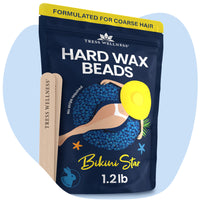Unwanted chin hair can be frustrating—especially if it’s something you’re dealing with regularly. For people with conditions like PCOD (Polycystic Ovarian Disease) or hormonal imbalances, facial hair growth on the chin can become even more frequent and noticeable. If you’re tired of constantly plucking or shaving, chin waxing might be the perfect solution. It offers longer-lasting smoothness and fewer ingrown hairs compared to other methods—and it’s something you can easily do at home with the right technique and products.
In this blog, we’ll cover everything you need to know about chin waxing, including how to wax your chin at home, tips for the best results, and why waxing is a better option for long-term hair removal.
What Is Chin Waxing?

Chin waxing is a method of hair removal where warm wax is applied to the skin and quickly pulled off, taking the unwanted hair out from the root. Unlike shaving, which only cuts hair at the surface, waxing pulls hair out from the follicle, giving you longer-lasting smoothness and slower regrowth.
For those struggling with PCOD or hormonal hair growth, chin waxing can be especially helpful. Hormonal imbalances often cause thicker, darker, and faster-growing facial hair, which can be difficult to manage with tweezing or shaving. Waxing removes even coarse and stubborn hair from the root, making it an effective solution for keeping your chin smooth for weeks at a time.
This technique also works well for different types of chin hair—whether it’s soft peach fuzz or thicker, darker strands. Plus, with consistent waxing, hair often grows back finer and sparser over time.
Benefits of Chin Waxing
If you’re dealing with frequent or excessive chin hair, waxing offers several advantages that make it a much better option compared to shaving or tweezing:
-
Longer-lasting results – Waxing pulls hair from the root, keeping your skin smooth for three to six weeks—unlike shaving, where stubble can appear within days.
-
Softer and finer regrowth – With regular waxing, the hair often grows back finer and less noticeable over time. This is especially helpful for those with PCOD, where hair growth can sometimes feel hard to manage.
-
Fewer ingrown hair – Shaving cuts hair at the surface, making it easier for hair to curl back into the skin and cause ingrown hairs. Waxing reduces this risk by removing hair from the root.
-
Exfoliated, smoother skin – Waxing not only removes hair but also gently exfoliates the skin, getting rid of dead skin cells and leaving your face feeling fresh and soft.
-
Time-saving and efficient – Instead of tweezing individual hairs daily, waxing lets you remove multiple hairs in one go—making it a faster, more convenient option.
For those dealing with hormonal facial hair, the longer-lasting effects of waxing can reduce the need for constant hair removal, giving you more freedom and confidence in your skincare routine.
How to Wax Your Chin at Home?

Waxing your chin at home is easy if you follow the right steps. Here’s a simple guide to get the best results:
1. Choose the Right Wax
Hard wax is the best option for facial hair because it’s gentle on delicate skin and grips short, fine hairs well. Unlike soft wax, it hardens on the skin and doesn’t require wax strips for removal.
A high-quality at-home wax kit, like one with hard wax beads, will make the process smoother and more effective. Tress Wellness hard wax kit is perfect for face waxing for beginners.
2. Prep Your Skin
Proper skin preparation helps the wax stick better and reduces irritation.
-
Cleanse your skin with a gentle, fragrance-free face wash to remove oil, makeup, and dirt.
-
Lightly exfoliate your chin 24 hours before waxing to prevent ingrown hairs.
-
Avoid using moisturizers or oils on the day of waxing—they can create a barrier that prevents the wax from gripping the hair.
3. Melt the Wax
Follow the instructions on your wax kit to heat the wax to the right consistency. It should be warm and spreadable, like thick honey—not too runny or too solid.
Always test the temperature on your wrist first to avoid burns on your face.
4. Apply the Wax
Use a small applicator stick for better control and precision on your chin area.
-
Apply the wax in the direction of hair growth in a smooth, even layer.
-
Wait a few seconds for the wax to cool and harden. It should no longer be sticky but still flexible.
5. Remove the Wax
Hold your skin taut with one hand to minimize discomfort and prevent pulling.
-
Quickly remove the wax strip or hardened wax in the opposite direction of hair growth.
-
Pull close to the skin—don’t yank upward—to reduce irritation and redness.
6. Soothe Your Skin
After waxing, your skin may be a little sensitive, so proper aftercare is essential.
-
Apply a post-waxing spray or soothing lotion with aloe vera or chamomile.
-
Avoid touching your chin too much to prevent irritation and bacteria transfer.
-
Skip makeup, exfoliating, or harsh skincare products for at least 24 hours.
Common Mistakes to Avoid When Waxing Your Chin
Waxing at home can be simple, but there are a few common mistakes you’ll want to avoid for the best results:
-
Skipping exfoliation – This increases the risk of ingrown hairs.
-
Using wax that’s too hot – Always test the temperature first to avoid burns.
-
Applying wax on dirty skin – Oil and dirt can prevent the wax from sticking properly.
-
Re-waxing the same area too much – This can lead to irritation and redness.
Why Waxing Is Better Than Other Methods?

While there are several ways to remove chin hair, waxing offers unique benefits that make it the better choice:
-
Shaving – Hair grows back quickly and feels stubbly. It also increases the risk of ingrown hairs.
-
Tweezing – It’s time-consuming and can irritate if you pluck too often.
-
Depilatory creams – They contain strong chemicals that can irritate sensitive facial skin.
With waxing, you get longer-lasting smoothness, softer regrowth, and fewer ingrown hairs—without the risk of stubble or harsh chemicals.
Final Thoughts
Chin waxing is an effective and convenient way to manage unwanted facial hair at home. For those dealing with hormonal imbalances like PCOD, where hair growth can feel excessive and tough to manage, waxing provides longer-lasting results and finer regrowth with consistent use.
By following the right techniques and using quality products, you can enjoy smooth, hair-free skin for weeks. If you’re ready to upgrade your hair removal routine, consider trying an at-home hard wax kit. With the right prep, application, and aftercare, you’ll get salon-quality results without the hefty price tag.




